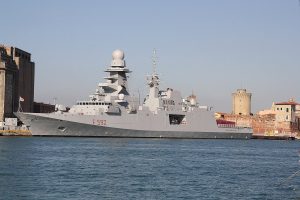By Sebastian Strangio

Last week, the Italian shipbuilder Fincantieri announced that it had reached a deal with Indonesia’s Ministry of Defense to supply it with eight frigates, marking a further step forward in the modernization of the country’s aging navy.
In a statement posted on its website on June 10, Fincantieri stated that Indonesia will purchase six new FREMM multipurpose frigates and two secondhand Maestrale-class frigates. The latter two vessels will be available after they are retired by the Italian Navy.
The purchase, the latest in a string of acquisitions by the Indonesian Navy, highlights the country’s mounting concerns about its ability to defend its vast ocean reaches with the navy’s current fleet of aging vessels.
The Navy’s shortcomings were tragically demonstrated by the April 21 sinking of the Indonesian submarine KRI Nanggala, with the loss of all 53 of its crew. The sub, which was built in 1977 in Germany, acquired by Indonesia in 1981, and refurbished by South Korea in 2012, was likely hit by a giant undersea wave while conducting live-fire torpedo exercises off the coast of Bali.
The poor state of the Indonesian Navy has compromised its ability to meet the mounting number of maritime challenges. While Jakarta is not a formal claimant in the South China Sea, some of its waters lie on the wrong side of Beijing’s expansive and legally dubious “nine-dash line” maritime claim, resulting in a series of recent stand-offs.
Over the past few years, the Indonesian National Armed Forces (TNI) have bolstered their presence on Natuna Besar, the largest of the islands in the area, and held military exercises in surrounding waters. Indonesia is also facing a growing number of challenges resulting from illegal fishing operations by vessels from China, Vietnam, Malaysia, and other nearby nations.
The Italian deal follows Indonesia’s signing of an agreement with Japan allowing the transfer of Japanese military equipment and technology to the Indonesian armed forces,. This was followed shortly by the news that Indonesia was gearing up to spend $3.6 billion on the procurement of up to eight of Japan’s new Mogami-class stealth frigates.
Following the loss of the KRI Nanggala, the Indonesian Navy also indicated that it was seeking to expand its submarine fleet by as much as threefold, from the current four to 12 vessels. Specifically, Indonesia is pursuing a joint production agreement with South Korea, while other potential deals are in the offing with France, Russia, and Turkey. Japan is also exploring the idea of selling submarines to the Indonesian Navy.
All of these acquisitions are part of a significant planned boost in Indonesia’s defense spending. A recently leaked government document outlined Defense Minister Prabowo Subianto’s plans to fortify the military with spending of $125 billion over five years, around three times the funding allocated for the past five years. Whether this eventuates remains to be seen, given the controversy that the plan evoked in the midst of the COVID-19 pandemic. In 2021, Indonesia’s military budget increased by 11 percent to around $9.2 billion.
Indonesia’s military modernization plans date back to 2007, and in 2010, the Indonesian Navy launched its Minimum Essential Force Strategy with a view to updating and upgrading its fleet and equipment by 2024. Despite these efforts, Indonesian defense spending remains the second-lowest in Southeast Asia relative to gross domestic product; the nation spent just 0.7 percent of its GDP on its military in 2019, compared to 1 percent for Malaysia, 1.3 percent for Thailand, and 3.2 percent for Singapore.
The navy has also been hampered by an overwhelming focus on the country’s land forces, a byproduct both of longstanding inter-service rivalries and the TNI’s historical focus on the suppression of regional rebellions in regions like Aceh and East Timor. Nonetheless, the Fincantieri purchase marks an important step for the world’s largest archipelagic nation to acquire a maritime security capability worthy of the name.
No comments:
Post a Comment